Design Study of a Round Window Piezoelectric Transducer for Active Middle Ear Implants
Abstract
:1. Introduction
2. Piezoelectric Transducer Design
2.1. RW Drive Piezoelectric Transducer
2.2. Mechanical Vibration Analysis
3. Piezoelectric Transducer Implementation
3.1. Fabrication of Transducer
3.2. Transducer Output Characteristics
4. Discussion and Summary
Funding
Institutional Review Board Statement
Informed Consent Statement
Conflicts of Interest
References
- Gesing, A.L.; Masson, Z.N.; Arellano, D.C.; Alves, F.; Paul, S.; Cordioli, J.A. Middle ear ossicular chain vibration detection by means of an optimized MEMS piezoelectric accelerometer. IEEE Sens. J. 2019, 19, 2079–2086. [Google Scholar] [CrossRef]
- Calero, D.; Paul, S.; Gesing, A.; Alves, F.; Cordioli, J.A. A technical review and evaluation of implantable sensors for hearing devices. Biomed. Eng. Online 2018, 17, 23. [Google Scholar] [CrossRef] [PubMed] [Green Version]
- Seidman, M.D.; Janz, T.A.; Shohet, J.A. Totally Implantable Active Middle Ear Implants. Otolaryngol. Clin. N. Am. 2019, 52, 297–309. [Google Scholar] [CrossRef] [PubMed]
- Gamm, U.A.; Grossöhmichen, M.; Salcher, R.B.; Prenzler, N.K.; Lenarz, T.; Maier, H. Optimum Coupling of an Active Middle Ear Actuator: Effect of Loading Forces on Actuator Output and Conductive Losses. Otol. Neurotol. 2019, 40, 789–796. [Google Scholar] [CrossRef]
- Zenner, H.P.; Leysieffer, H. Total implantation of the implex TICA hearing amplifier implant for high-frequency sensorineural hearing loss: The tübingen university experience. Otolaryngol. Clin. N. Am. 2001, 34, 417–446. [Google Scholar]
- Jenkins, H.A.; Atkins, J.S.; Horlbeck, D.; Hoffer, M.E.; Balough, B.; Arigo, J.V.; Alexiades, G.; Garvis, W. US phase I preliminary results of use of the otologics MET fully-implantable ossicular stimulator. Otolaryngol. Head Neck Surg. 2007, 137, 206–212. [Google Scholar] [CrossRef]
- Chen, D.A.; Backous, D.D.; Arriaga, M.A.; Garvin, R.; Kobylek, D.; Littman, T.; Walgren, S.; Lura, D. Phase 1 clinical trial results of the Envoy system: A totally implantable middle ear device for sensorineural hearing loss. Otolaryngol. Head Neck Surg. 2004, 131, 904–916. [Google Scholar] [CrossRef]
- Ko, W.H.; Zhang, R.; Huang, P.; Guo, J.; Ye, X.; Young, D.J.; Megerian, C.A. Studies of MEMS acoustic sensors as implantable microphones for totally implantable hearing-aid systems. IEEE Trans. Biomed. Circuits Syst. 2009, 3, 277–285. [Google Scholar] [CrossRef]
- Sachse, M.; Hortschitz, W.; Stifter, M.; Steiner, H.; Sauter, T. Design of an implantable seismic sensor placed on the ossicular chain. Med. Eng. Phys. 2013, 35, 1399–1405. [Google Scholar] [CrossRef]
- Bruschini, L.; Forli, F.; Passetti, S.; Bruschini, P.; Berrettini, S. Fully implantable otologics MET Carina device for the treatment of sensorineural and mixed hearing loss: Audio-otological results. Acta Otolaryngol. 2010, 130, 1147–1153. [Google Scholar] [CrossRef]
- Eßinger, T.M.; Koch, M.; Bornitz, M.; Lasurashvili, N.; Neudert, M.; Zahnert, T. Sensor-actuator component for a Floating Mass Transducer-based fully implantable hearing aid. Hear. Res. 2019, 378, 157–165. [Google Scholar] [CrossRef] [PubMed]
- Lenarz, T.; Zimmermann, D.; Maier, H.; Busch, S. Case report of a new coupler for round window application of an active middle ear implant. Otol. Neurotol. 2018, 39, e1060–e1063. [Google Scholar] [CrossRef] [PubMed]
- Shin, D.H.; Seong, K.W.; Nakajima, H.H.; Puria, S.; Cho, J.H. A piezoelectric bellows round-window driver (PBRD) for middle-ear implants. IEEE Access 2020, 8, 137947–137954. [Google Scholar] [CrossRef]
- Liu, H.; Wang, H.; Rao, Z.; Yang, J.; Yang, S. Numerical Study and Optimization of a Novel Piezoelectric Transducer for a Round-Window Stimulating Type Middle-Ear Implant. Micromachines 2019, 10, 40. [Google Scholar] [CrossRef] [PubMed] [Green Version]
- Lefebvre, P.P.; Martin, C.; Dubreuil, C.; Decat, M.; Yazbeck, A.; Kasic, J.; Tringali, S. A pilot study of the safety and performance of the Otologics fully implantable hearing device: Transducing sounds via the round window membrane to the inner ear. Audiol. Neurotol. 2009, 14, 172–180. [Google Scholar] [CrossRef]
- Renninger, D.; Ernst, A.; Todt, I. MRI scanning in patients implanted with a round window or stapes coupled floating mass transducer of the Vibrant Soundbridge. Acta Otolaryngol. 2016, 136, 241–244. [Google Scholar] [CrossRef]
- Bruchhage, K.L.; Leichtle, A.; Schönweiler, R.; Todt, I.; Baumgartner, W.D.; Frenzel, H.; Wollenberg, B. Systematic review to evaluate the safety, efficacy and economical outcomes of the Vibrant Soundbridge for the treatment of sensorineural hearing loss. Eur. Arch. Oto-Rhino-L. 2017, 274, 1797–1806. [Google Scholar] [CrossRef]
- Shimizu, Y.; Puria, S.; Goode, R.L. The floating mass transducer on the round window versus attachment to an ossicular replacement prosthesis. Otol. Neurotol. 2011, 32, 98–103. [Google Scholar] [CrossRef] [Green Version]
- Nakajima, H.H.; Dong, W.; Olson, E.S.; Rosowski, J.J.; Ravicz, M.E.; Merchant, S.N. Evaluation of round window stimulation using the floating mass transducer by intracochlear sound pressure measurements in human temporal bones. Otol. Neurotol. 2010, 31, 506–511. [Google Scholar] [CrossRef] [Green Version]
- Shin, D.H.; Cho, J.H. Piezoelectric actuator with frequency characteristics for a middle-ear implant. Sensors 2018, 18, 1694. [Google Scholar] [CrossRef] [Green Version]
- Balachandran, B.; Magrab, E.B. Vibrations, 2nd ed.; Cengage Learning: Toronto, ON, Canada, 2009; pp. 69–174. [Google Scholar]
- Barbara, M.; Filippi, C.; Tarentini, S.; Covelli, E.; Monini, S. Rehabilitation of severe-to-profound sensorineural hearing loss with an active middle ear implant. Acta Otolaryngol. 2020, 140, 236–241. [Google Scholar] [CrossRef] [PubMed]
- Brkic, F.F.; Riss, D.; Auinger, A.; Zoerner, B.; Arnoldner, C.; Baumgartner, W.D.; Wolfgang, G.; Vyskocil, E. Long-Term Outcome of Hearing Rehabilitation with An Active Middle Ear Implant. Laryngoscope 2019, 129, 477–481. [Google Scholar] [CrossRef] [PubMed] [Green Version]
- McRackan, T.R.; Clinkscales, W.B.; Ahlstrom, J.B.; Nguyen, S.A.; Dubno, J.R. Factors associated with benefit of active middle ear implants compared to conventional hearing aids. Laryngoscope 2018, 128, 2133–2138. [Google Scholar] [CrossRef] [PubMed]
- Haynes, D.S.; Young, J.A.; Wanna, G.B.; Glasscock, M.E. Middle ear of implantable hearing devices: An overview. Trends Amplif. 2009, 13, 206–214. [Google Scholar] [CrossRef]
- Assmann, P.; Summerfield, Q. The perception of speech under adverse conditions. In Speech Processing in the Auditory System; Springer: New York, NY, USA, 2004; pp. 231–308. [Google Scholar]
- Shin, D.H.; Seong, K.W.; Puria, S.; Lee, K.Y.; Cho, J.H. A tri-coil bellows-type round window transducer with improved frequency characteristics for middle-ear implants. Hear. Res. 2016, 341, 144–154. [Google Scholar] [CrossRef] [Green Version]
- Shin, D.H.; Cho, J.H. Design and development of a tri-coil bellows transducer for RW-drive implantable middle-ear hearing aid using FEA. IEEE/ASME Trans. Mechatron. 2018, 23, 1436–1444. [Google Scholar] [CrossRef]
- Fischer, S.C.; Kruttwig, K.; Bandmann, V.; Hensel, R.; Arzt, E. Adhesion and Cellular Compatibility of Silicone-Based Skin Adhesives. Macromol. Mater. Eng. 2017, 302, 1600526. [Google Scholar] [CrossRef]
- Shakeel, M.; Spielmann, P.M.; Jones, S.E.; Hussain, S.S.M. Direct measurement of the round window niche dimensions using a 3-dimensional moulding technique–a human cadaveric temporal bone study. Clin. Otolaryngol. 2015, 40, 657–661. [Google Scholar] [CrossRef]
- Lei, K.F.; Lee, K.F.; Lee, M.Y. Development of a flexible PDMS capacitive pressure sensor for plantar pressure measurement. Microelectron. Eng. 2012, 99, 1–5. [Google Scholar] [CrossRef]
- Lee, S.H.; Seong, K.W.; Lee, K.Y.; Shin, D.H. Optimization and performance evaluation of a transducer for bone conduction implants. IEEE Access 2020, 8, 100448–100457. [Google Scholar] [CrossRef]
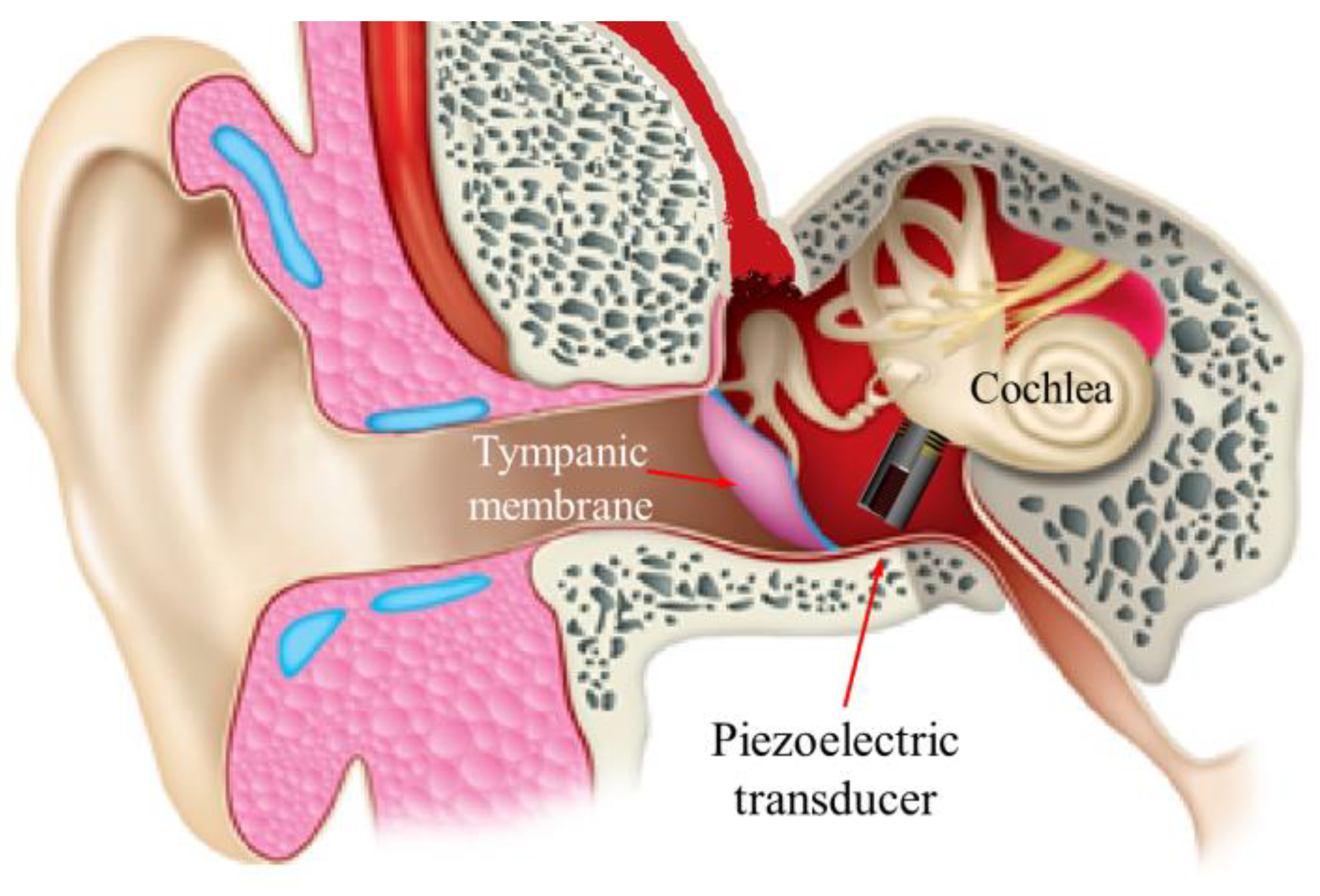
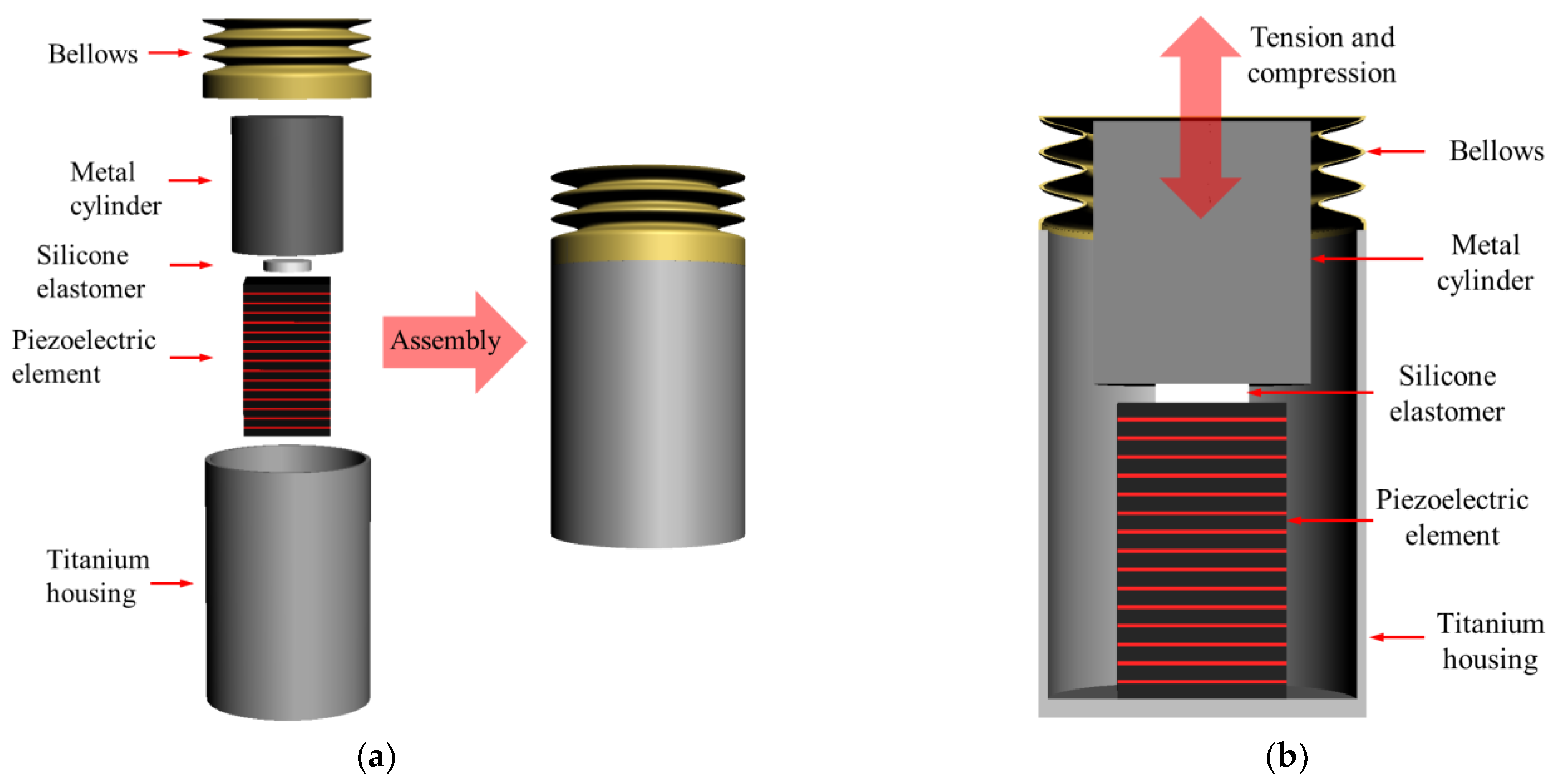
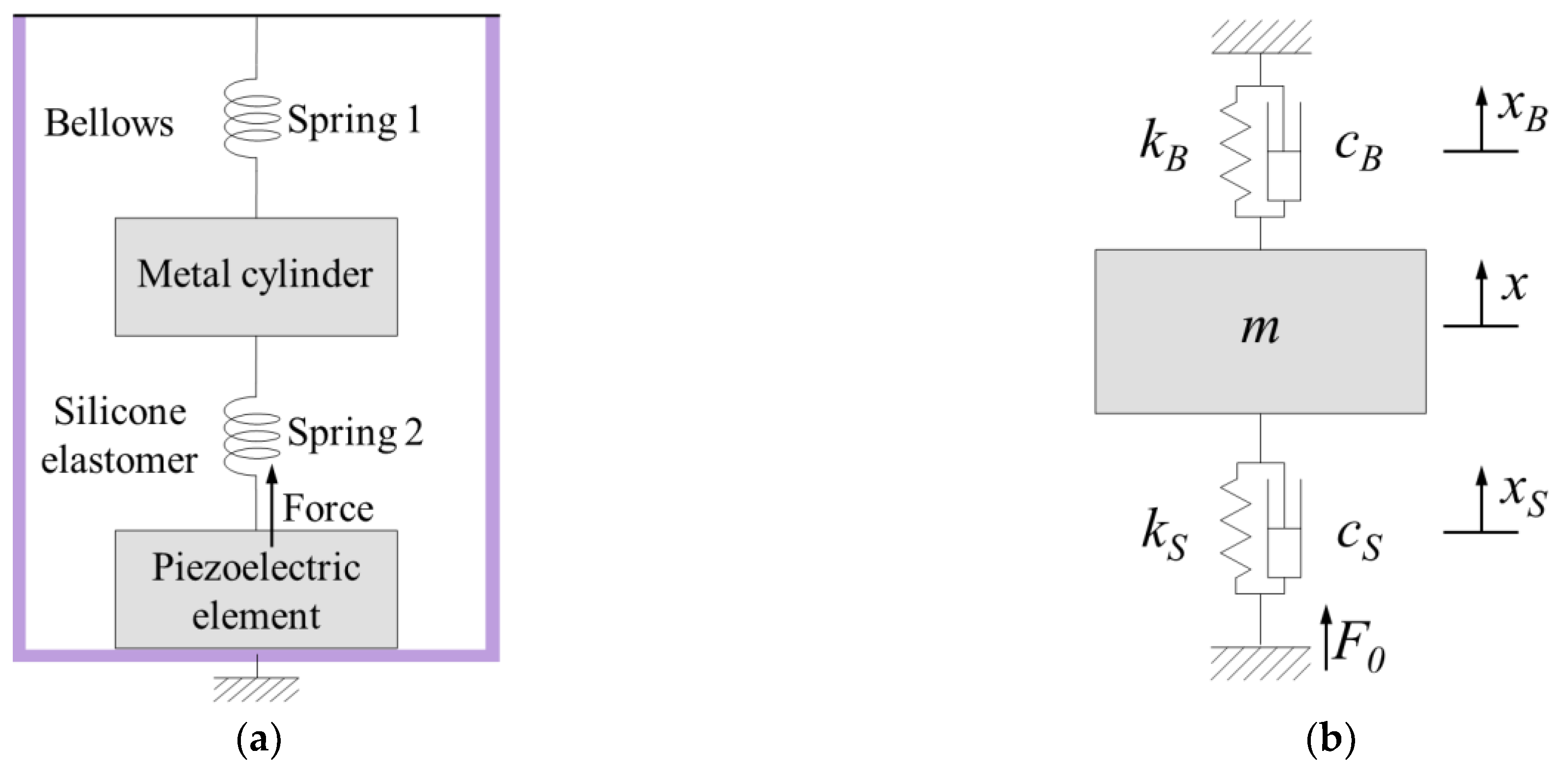
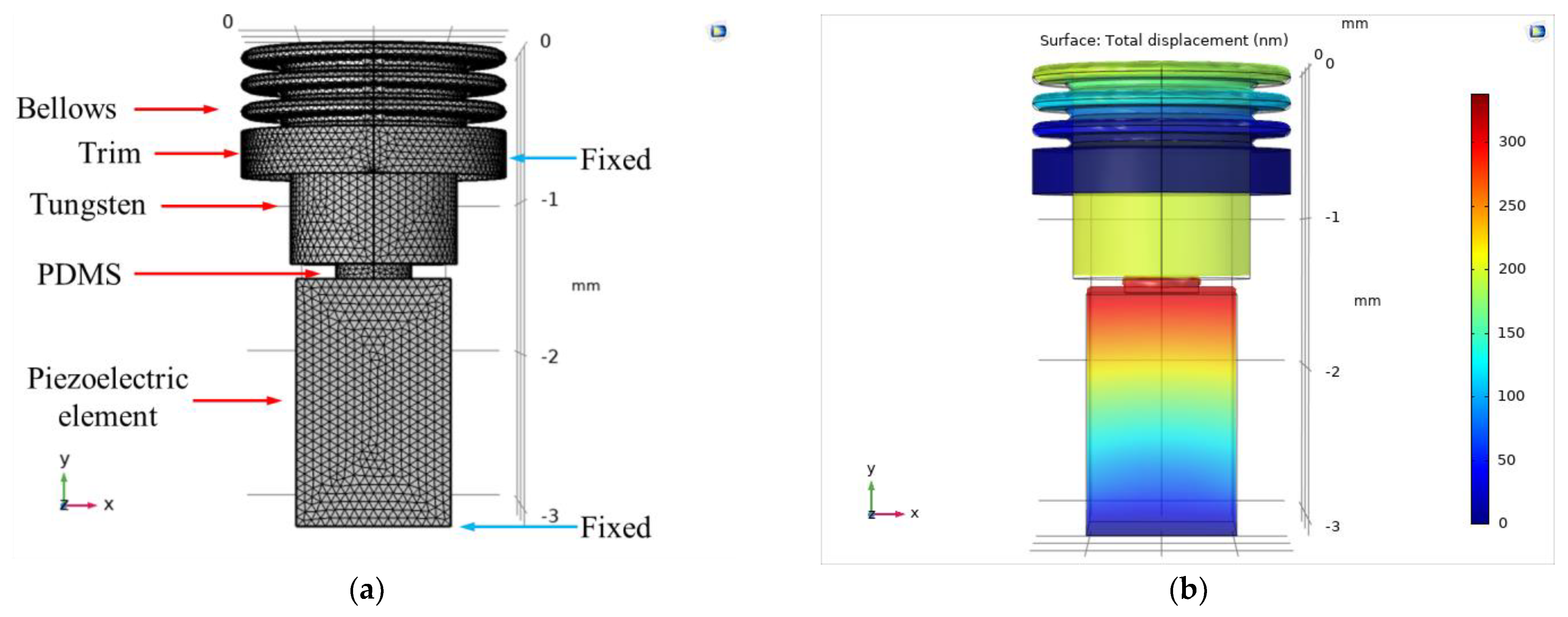


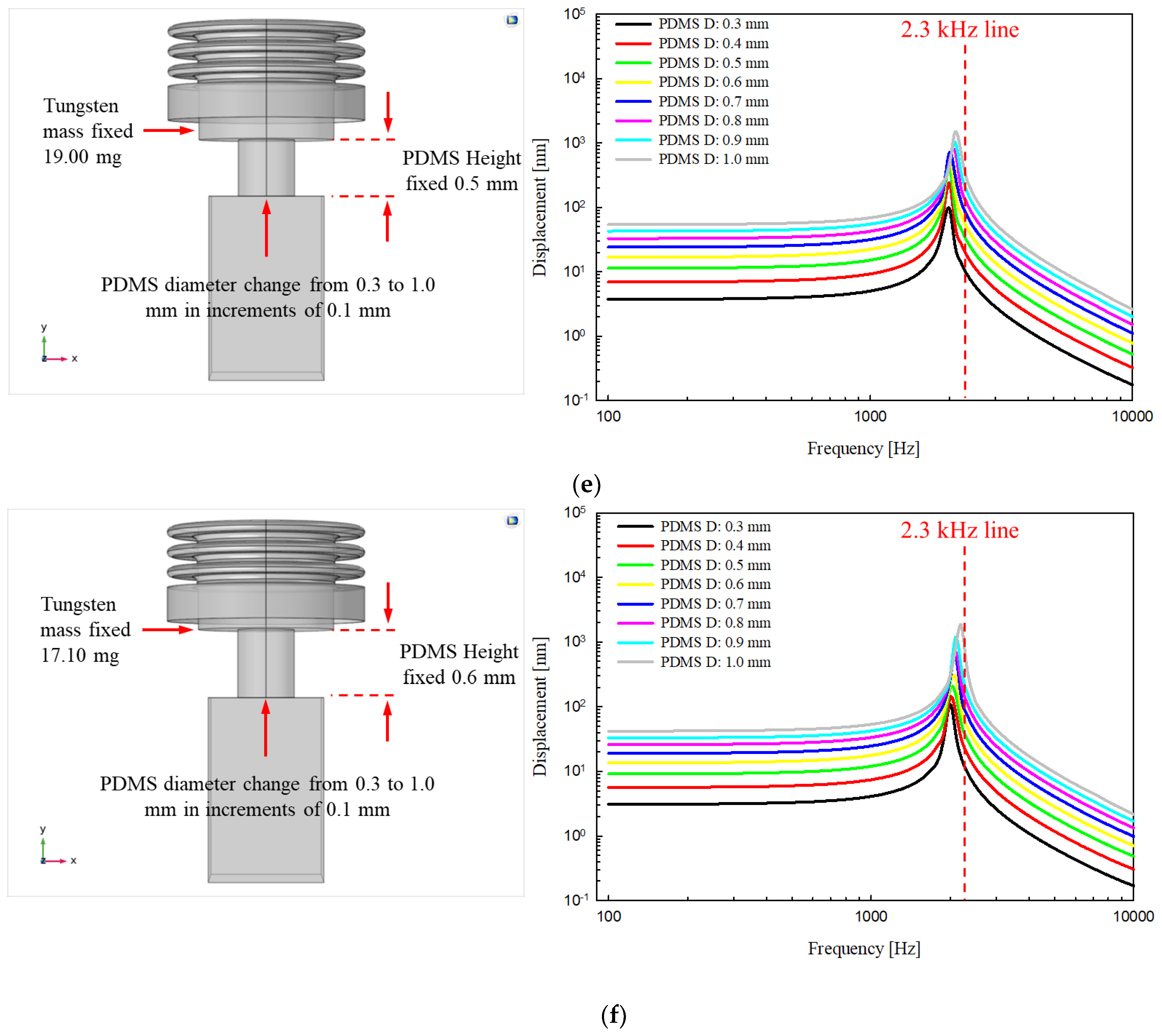


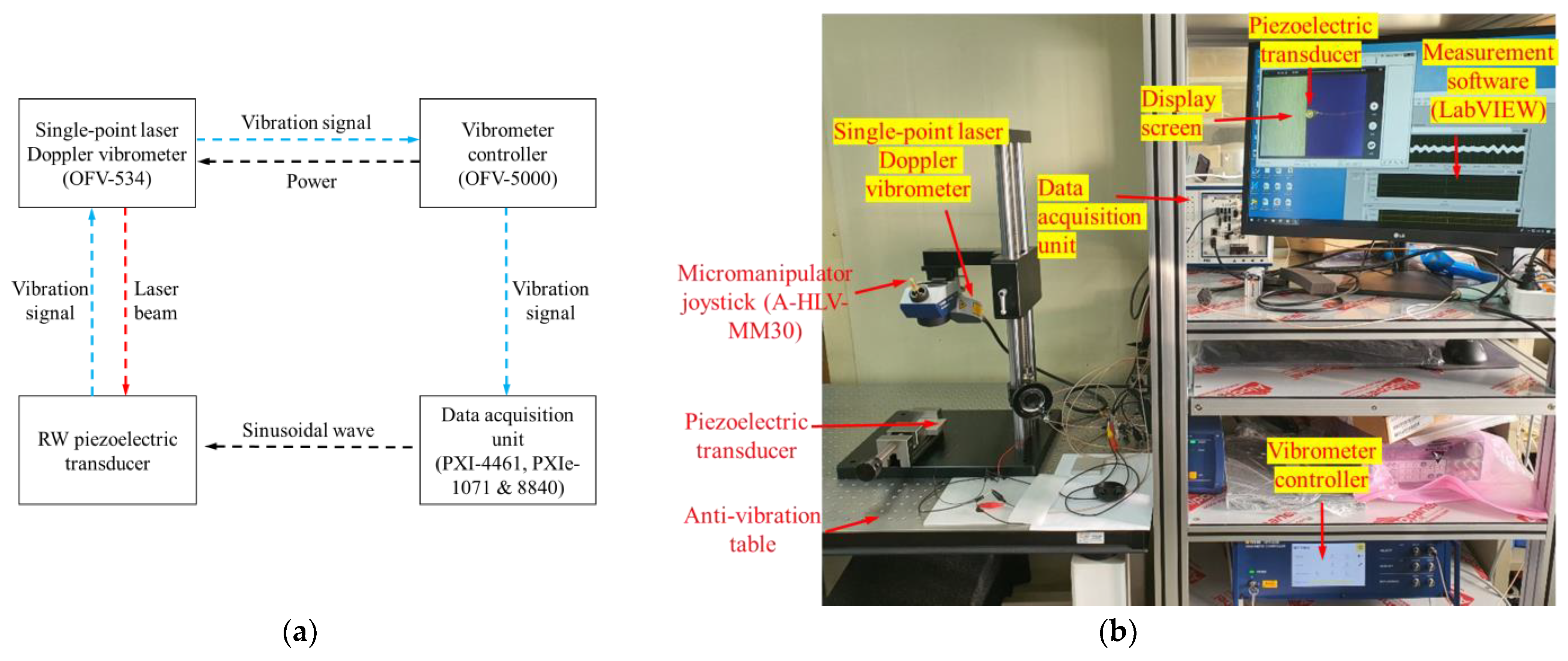

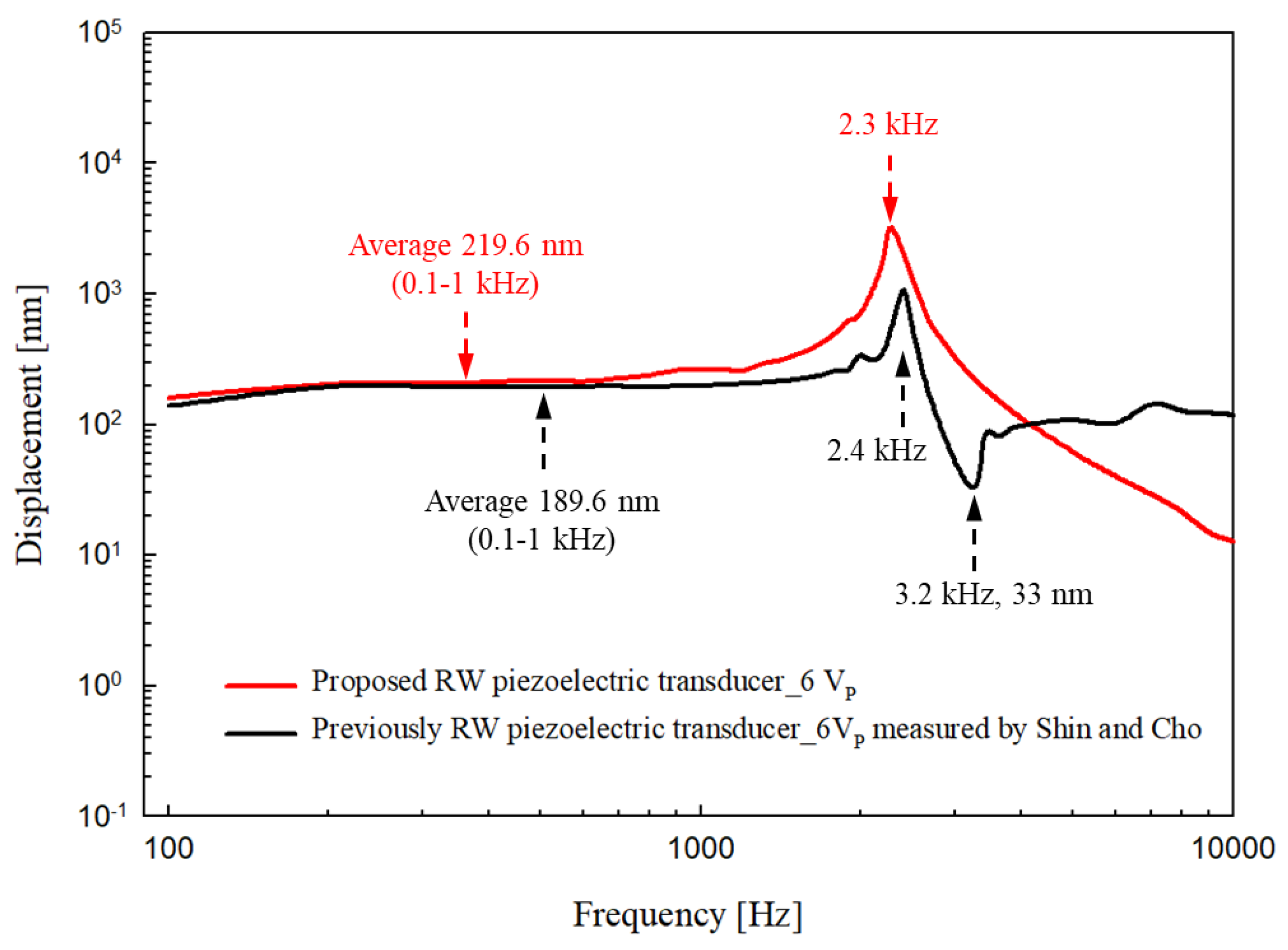
Publisher’s Note: MDPI stays neutral with regard to jurisdictional claims in published maps and institutional affiliations. |
© 2021 by the author. Licensee MDPI, Basel, Switzerland. This article is an open access article distributed under the terms and conditions of the Creative Commons Attribution (CC BY) license (http://creativecommons.org/licenses/by/4.0/).
Share and Cite
Shin, D.H. Design Study of a Round Window Piezoelectric Transducer for Active Middle Ear Implants. Sensors 2021, 21, 946. https://doi.org/10.3390/s21030946
Shin DH. Design Study of a Round Window Piezoelectric Transducer for Active Middle Ear Implants. Sensors. 2021; 21(3):946. https://doi.org/10.3390/s21030946
Chicago/Turabian StyleShin, Dong Ho. 2021. "Design Study of a Round Window Piezoelectric Transducer for Active Middle Ear Implants" Sensors 21, no. 3: 946. https://doi.org/10.3390/s21030946





